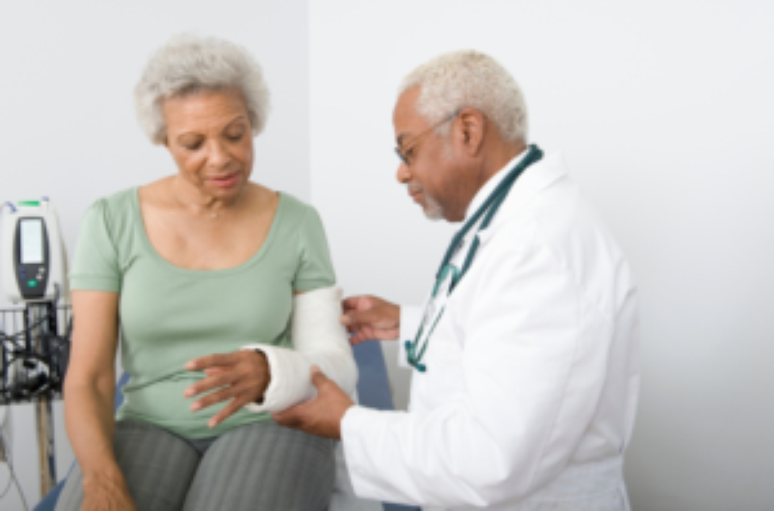The expert explains the main causes and gives advice on how to prevent fractures.
As we age, it is natural that our bodies no longer have the same resistance as they once did. In a scenario like this, the possibility of fractures is one of the main risks for the quality of life of the elderly worldwide. In cases like this, one of the main reasons are domestic accidents associated with already weakened muscles and even reduced vision and hearing. Older adults end up becoming more susceptible to falls and other situations that didn’t previously present as many risks. However, solutions can be found to minimize these chances. Therefore, in today’s article you will better understand fractures in the elderly and how to prevent them. Furthermore, Dr. Demian Miziara Amaral, Specialist in Orthopedics with a focus on the Frailty of the Elderly, brings some suggestions. Keep reading!
What are the most common causes and fractures in the elderly?
Falls are the leading cause of fractures in the elderly. A recent study by the World Health Organization has shown that around 35% of people over 65 in the world suffer from it at least once a year. Furthermore, this number can exceed 40% when entering even larger age groups. These numbers show that one in three older people go through a situation like this on a regular basis. These falls are quite common especially at home. A trip on a badly placed mat, for example, can be enough for this. When walking on the street, uneven sidewalks or potholes in the path are also a risky situation. Therefore, these accidents can cause irreversible damage to the health of the elderly. According to orthopedic surgeon Dr. Demian Miziara Amaral, the most common fractures are:
- of the distal radius (wrist);
- of the lumbar spine;
- from the pelvis;
- of the ribs;
- of the proximal femur.
These fractures can reduce the independence of older adults from basic daily activities. Of these, the femur may present the worst risks, including the inability to walk.
html[data-range=”xlarge”] figure image img.img-3cc36a4cb1da12c9556c48235e92fba3f99c518z { width: 774px; height: 511px; }HTML[data-range=”large”] figure image img.img-3cc36a4cb1da12c9556c48235e92fba3f99c518z { width: 548px; height: 362px; }HTML[data-range=”small”] figure image img.img-3cc36a4cb1da12c9556c48235e92fba3f99c518z, html[data-range=”medium”] figure image img.img-3cc36a4cb1da12c9556c48235e92fba3f99c518z { width: 564px; height: 372px; }
What are the main post-fracture risks?
When we talk about fractures and health risks, we immediately think of the tiring recovery times. This equation also includes the possible costs of surgery and medicines, which can often represent a large impact on the monthly budget of families. However, according to Dr. Demian Miziara Amaral, the post-fracture risks go further. According to him, the side effects of the drugs have to be considered. ”
The main risk of these fractures, in general, is the increased consumption of analgesic drugs
, leading to sedation and the possibility of constipation and delirium. Specifically, fractures of the spine and proximal femur cause a lot of disability and limit the autonomy of the elderly. It can even lead to death,” explains orthopaedist Dr. Demian Miziara Amaral. In addition, other issues must be taken into account, especially in the psychological sphere. These impacts and the lack of mobility, for example, can greatly affect the mental health of the They can also generate fear of doing certain activities that previously seemed common.
How to prevent injuries?
While accidents and injuries are common to anyone regardless of age, the risks may be greater in the elderly. Therefore, it is essential to find strategies to avoid these situations. ”
The best forms of prevention are to avoid falls.
. Remove carpets and steps from the floor, avoid moving furniture, diagnose and treat possible causes of vertigo”, explains the orthopedic surgeon. There are therefore some practices to adopt to minimize risk scenarios, such as:
1 – Evaluation of the house to eliminate the risks
As Dr. Demian explained, attention to detail in the home is key. Therefore, it is important that the older person and their family can evaluate the home and remove obstacles that may cause trips and, consequently, falls. Another interesting point is that, when the house has a second floor, it is essential to place a handrail to support its ascent and descent. In bathrooms, for example, there should also be grab bars and non-slip floors. In cases where the elderly’s mobility is already somewhat compromised, even without a previous fracture, it is interesting to consider using a cane or something to help with walking. In this way the house becomes a safer environment.
2 – Practice physical activity regularly
In addition to taking care of the house, it is very important to incorporate physical activities into everyday life. In this way it is possible to strengthen the muscles and improve the mobility for carrying out daily activities. These exercises don’t even have to be heavy or require great effort on the part of the elderly person. The practice of pilates or bodybuilding, always accompanied by a professional, can already be enough. Light aerobics, such as walking or water aerobics, can help strengthen the body. In addition, exercises that increase flexibility also play an important role, such as yoga.
3 – Maintain a regular exam routine
Finally, a regular checkup routine will also help prevent fractures. This means doing physical, vision, hearing, etc. exams frequently. All to ensure that the elderly remain able to carry out their daily activities safely.
In which cases is surgery recommended?
In many cases, surgery may be required. However, the older person’s health should be evaluated before making this decision. “In some specific cases, such as bedridden and frail patients,
conservative and sometimes even palliative treatment can bring more comfort
“, emphasizes Dr. Demian Miziara Amaral. Therefore, according to the orthopedist, the most important point of the treatment itself is to assess the patient’s degree of frailty and possible sequelae. In this way, by studying each case with the due particularities, it is possible to find the best solutions. In this way it is essential to work to minimize the possibility of accidents. Therefore, evaluating the house and making it safer is the first step and one of the more essential to make it possible. In addition, it is also important to maintain a routine of exercises and exams.
*Dr. Demian Miziara Amaral is a doctor specialized in General Orthopedics, Oncological Orthopedics and Orthopedics with particular attention to frailty in the elderly. He graduated in orthopedics, traumatology and orthopedic oncology from the ISCMSP. He works at Clínica SO.U at the Itaim and Bela Vista Units, in São Paulo.
Source: Terra
Ben Stock is a lifestyle journalist and author at Gossipify. He writes about topics such as health, wellness, travel, food and home decor. He provides practical advice and inspiration to improve well-being, keeps readers up to date with latest lifestyle news and trends, known for his engaging writing style, in-depth analysis and unique perspectives.








